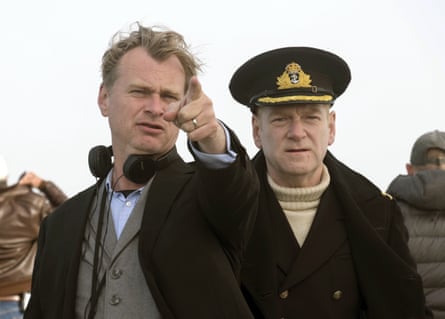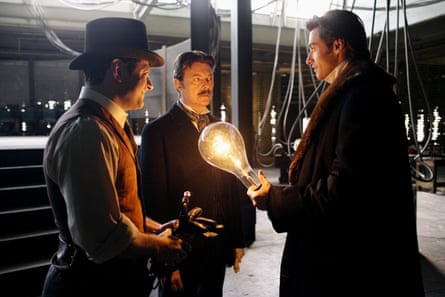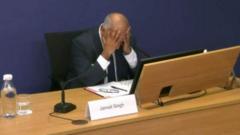Somewhere between the crowd-pleasing spectacle of Hollywood and the esoteric inventions of European cinema lies the work of Christopher Nolan, the London-born writer-director who next month will receive the British Film Institute’s highest honour – the fellowship. Hailed by the BFI as “a blockbuster auteur and champion of cinema”, five-time Academy Award nominee Nolan is tipped for success at last at the forthcoming Oscars with his recent Golden Globe winner Oppenheimer – a frontrunner for, among others, best film, best director and best adapted screenplay.
The fact that this darkly ruminative three-hour epic has become the highest grossing biopic of all time, outselling the poptastically entertaining Bohemian Rhapsody, says much about Nolan’s ability to connect with mainstream audiences. Stranger still, a substantial number of those who furrowed their brows through the existential crises of Oppenheimer went on to double-bill it with Greta Gerwig’s pink-hued Barbie, creating one of cinema’s most unlikely box-office bonanzas – Barbenheimer!
Nolan’s uncanny ability to meld high art and popular culture has always been one of his greatest strengths. I remember emerging from an early screening of the comic-strip superhero yarn Batman Begins (2005) and exclaiming to my friend and colleague Nigel Floyd: “Wow! That’s the most expensive arthouse film I’ve ever seen!”
From his made-on-the-cheap indie debut Following (1998) to his most recent blockbuster behemoth, Nolan has viewed cinema as both a magic lantern and a time machine, opting for narratives that shuffle time like a deck of cards. His breakthrough feature, Memento (2000, adapted from his screenwriter brother Jonathan’s short story Memento Mori), is an amnesiac thriller that uses a reversed-order narrative to reflect its protagonist’s inability to create and store new memories. Like its spiritual successor, Tenet (Nolan’s head-scrambling 2020 big-budget thriller in which contrapuntal time frames form a perfect cinematic palindrome), Memento assumes that any and all cinemagoers will, by the very nature of the medium, understand that time is reversible, flexible, artificial. Indeed, who has ever watched a Nolan film and not been intuitively aware that cinema somehow replicates the collage of memory – a random-access series of moving images that can be watched and rewatched, time and time again; faster, slower; forwards, backwards; ordered and reordered.

This simple truth is at the heart of so many of Nolan’s movies, from the slowed-down dreamscapes of Inception (2010), in which entire Bond-style action adventures play out in the time it takes a van to fall off a bridge, to the otherworldly time warps of 2014’s Interstellar (a trip to a distant planet rearranges the relative ages of crew members, and the central character winds up haunting himself) and the intertwined temporalities (one week, one day, one hour) of Dunkirk (2017). For proof that audiences are engaged rather than alienated by Nolan’s playful temporal knots, look no further than the fact that the three movies cited above have taken around $2bn between them, so they’re clearly hitting a popular nerve.
The other key element of Nolan’s cinema is magic, or more precisely the process of magic. A fierce champion of celluloid in the dawning digital era, Nolan has striven to make audiences acutely aware of the format of their screen entertainment, turning what might have been an esoteric discussion into a central selling point. Few fans of The Dark Knight (2008) were unaware that central action scenes were shot (and best viewed) in Imax, the large-frame format to which Nolan has devoted such creative energy, even using it to redefine the facial closeup in Oppenheimer. By the time of Dunkirk, tickets for Nolan’s films were being booked on the basis of screen size and projection processes, with audiences well-versed in the varying frame ratios, image clarity and even “footlambert” brightnesses of each different format.
That interest in process takes us back to the birth of cinema itself, to a time when magic lanterns conjured fairground phantasmagoria from machines that seemed simultaneously infernal and enchanted. No surprise, then, that perhaps Nolan’s finest (and most underrated) film is an adaptation of Christopher Priest’s 1995 novel The Prestige – a tale of rival stage magicians in Victorian London that fuses time shifts, teleportation and the spectre of electronic pioneer Nikola Tesla (a career-best turn from David Bowie) into its mesmerising mix.

Presented as a tragic love story and a behind-the-scenes glimpse into the mechanics of magic, The Prestige (2006) leads us through the three carefully choreographed movements of all great illusions: the pledge; the turn; the prestige. As we watch, we can almost feel Nolan lovingly unpicking the spellbinding history of cinema itself, inviting us to join him in a danse macabre of smoke and mirrors. We know it’s a trick, but it’s one in which we choose to invest – for the fleeting chance to experience transcendence in the company of others who, for a brief moment, share our waking dream.
All titles are available to rent on multiple platforms unless otherwise specified.
What else I’m enjoying

Monsters: A Fan’s Dilemma
Claire Dederer’s self-narrated audiobook of her 2023 bestseller about terrible people who make great art (from Picasso to Polanski) is compulsive listening – personal, political, profound.
Scala!!!
The UK release of Jane Giles and Ali Catterall’s thrilling doc about London’s wildest cinema club is accompanied by a BFI season showcasing some of the storied venue’s most notorious offerings, including Thundercrack! and Salo. Blimey.

.png)









